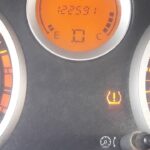Experiencing a dead OBD2 port on your 2003 Chevy 2500HD can be frustrating, especially when you need to diagnose engine issues or pass emissions tests. A non-functional OBD2 port often means your code reader or scanner won’t power up, leaving you in the dark about your truck’s health. Before assuming major electrical problems, a simple fuse check can often resolve this issue. This guide will walk you through the initial steps to troubleshoot a “no power” situation at your OBD2 connector, starting with the most common culprit: Fuse 13.
Often, the first and easiest point to investigate when facing a lack of power at the OBD2 port and potentially other related issues like a non-functioning cigarette lighter (or accessory power port) is Fuse 13, located in the underhood fuse box. Even if the fuses appear visually intact, they can still be defective. Internal breaks or oxidation on the fuse terminals can prevent proper electrical flow. It’s a quick and inexpensive check that can save you significant time and effort in diagnosing electrical problems.
To begin, locate the underhood fuse box on your 2003 Chevy 2500HD. Consult your owner’s manual for the precise location if needed. Once located, identify Fuse 13. It is typically a 20 Amp fuse and is often associated with the OBD2 port and auxiliary power outlets. Visually inspect Fuse 13 for any signs of burning or a broken filament. However, visual inspection alone isn’t always conclusive.
Alt text: Diagram of the underhood fuse box in a 2003 Chevy 2500HD highlighting the location of Fuse 13.
The most reliable first step is to replace Fuse 13 with a known good 20 Amp fuse. Ensure the replacement fuse is of the correct amperage to avoid further electrical issues. After replacing the fuse, check if the OBD2 port is now operational by plugging in your code reader or scanner. Additionally, test the cigarette lighter or accessory power port, as it often shares the same circuit. A successful fix at this stage indicates that the original Fuse 13 was indeed faulty.
If replacing Fuse 13 doesn’t restore power to the OBD2 port or the cigarette lighter, the next step involves using a multimeter to diagnose the circuit further. Set your multimeter to the DC Volts setting. Ground the negative (black) lead of the multimeter to a suitable ground point in the vehicle, such as a clean, unpainted metal surface. With the positive (red) lead, carefully probe both exposed metal contacts on the top of Fuse 13 while it is installed in the fuse box. You should see a reading of approximately 12 Volts on both sides of the fuse if it’s receiving and passing power correctly.
Alt text: Using a digital multimeter to perform a voltage test across the terminals of Fuse 13 in a Chevy 2500HD fuse box.
If you are not getting 12V on either side of Fuse 13, or only on one side, this indicates a problem upstream of the fuse, or potentially a wiring issue between the fuse box and the OBD2 port. If you see 12V on the input side of Fuse 13 but not the output side, and you’ve already replaced the fuse, there might be an issue with the fuse box itself or the connections within it.
To check for continuity between the fuse box and the OBD2 port, switch your multimeter to the Ohms setting (continuity test). Remove Fuse 13 for this test to avoid damaging your meter or vehicle circuits. Connect one lead of your multimeter to the load side contact in the Fuse 13 socket (the side that did not show 12V when tested earlier) and the other lead to Pin 16 of the OBD2 connector. Pin 16 is the power pin on the OBD2 connector and is typically located at the top right when looking at the connector. You should see a reading of near zero ohms or a continuity beep, indicating a continuous wire. If you see infinite resistance or no continuity, there is a break or open circuit in the wiring between Fuse 13 and the OBD2 port, which will require further tracing and inspection of the wiring harness.
Alt text: Diagram illustrating the pinout of a standard OBD2 connector, specifically highlighting Pin 16 as the power supply pin.
This initial troubleshooting focusing on Fuse 13 and basic voltage and continuity checks will resolve the no power issue at the OBD2 connector for many 2003 Chevy 2500HD owners. If these steps don’t solve the problem, more in-depth electrical diagnosis might be necessary, potentially involving checking the wiring harness for damage, inspecting connectors for corrosion, or even considering potential issues with the Powertrain Control Module (PCM).
By systematically checking the fuse and the circuit with a multimeter, you can effectively pinpoint the cause of the “no power” issue at your 2003 Chevy 2500HD’s OBD2 connector and take the appropriate steps to restore its functionality. Remember to consult a wiring diagram specific to your vehicle for accurate circuit tracing if needed. If you are uncomfortable with electrical diagnostics, seeking assistance from a qualified automotive technician is always a prudent next step.
